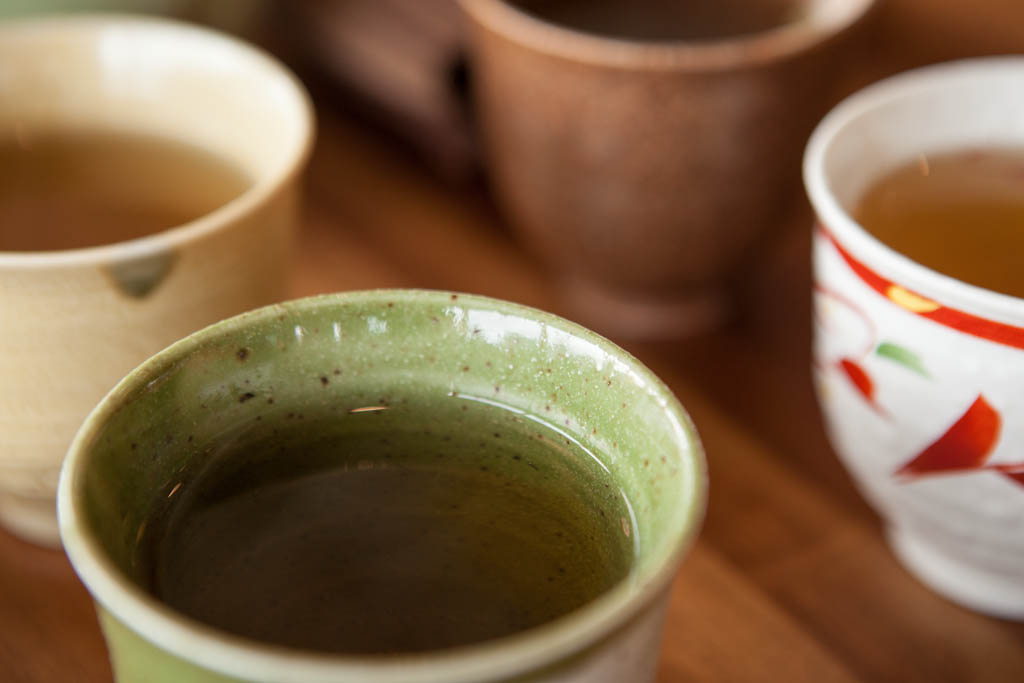Tea Brewing and Storage
Brewing tea from loose leaves is simple enough. There are many ways to prepare tea. Feel free to experiment and let your palate be the guide. Start with fresh, good-tasting water.
Preheat the teapot and/or cup(s)
It is important to preheat the pot or cup in which the tea will be steeped. If hot water is poured into a cold vessel, the temperature of the water will drop too quickly and the full flavor of the tea will not be extracted. To preheat the pot: pour a little of the boiling water from the kettle into the pot and then pour this water off into the drinking cups to warm them.
Measure the appropriate amount of dry leaves
Ideally, 3 grams of dry leaves should be used for every 6 ounces of water. Since you may not have a gram weight scale, we recommend starting with one rounded teaspoon of dry leaves for each 6-ounce cup. Since different teas vary in weight, it is important to adjust the amount of dry leaves accordingly. With lighter weight teas such as long leaf greens and white teas, try 2 teaspoons per 6 oz cup.
Select the right water temperature
Black, Dark Oolong, Herbal - These types are best prepared with water that has come to near boiling. Don't let the water boil too long or the oxygen content will be reduced and the tea will taste flat.
Green, White, “Green” Oolongs - These types should not be prepared with boiling water as this will cook the leaves and destroy their flavor. Japanese greens tend to taste best with water at 170-180 F. China green teas tend to taste best with water at 185 F. Generally, the finer the green tea, the lower the water temperature should be.
The time it takes for tea to brew depends on the leaf size. The smaller the leaf, the faster the tea infuses. Until familiar with a particular tea, steep for a minute or two, then taste. Pay attention to the taste rather than the color. When the tea tastes right, serve or pour off all the liquid to avoid oversteeping.
Here are some general guidelines: 
Sencha Green Tea: 1-2 minutes
Chinese Green Teas: 2-3 minutes
Long Leaf Green & White Teas: 2-5 minutes
Green Oolong Teas: 2-3 minutes
Dark Oolong Teas: 3-5 minutes
Black Teas & Puerh: 3-5 minutes
Herbal Infusions: 5-10 minutes
Some green, oolong and white teas are good for multiple infusions. Just add fresh hot water to the pot and increase the steeping time slightly for each subsequent infusion. Repeat until the flavor starts to fade.
Making White Heron Chai at home
Making great chai at home isn't rocket science, but does require different approach than brewing most other teas. The best method involves simmering tea and spices in hot water, then adding sugar and milk, soy milk or other milk alternative. The result is classic Indian style chai. Happy brewing, Chai Garam!
Equipment Needed:
- 1 Qt Saucepan
- Loose Chai, Sugar (or Honey, Maple syrup, Stevia)
- Milk, Soy or Almond Milk
- Small Fine Mesh Strainer that will fit in a cup or teapot
- Teapot or Cups to Strain Chai into
- Add 1 pint water to saucepan.
- Heat on stove until water comes to a boil.
- Add 2 Tbsp loose Chai + 2 Tbsp sugar (or honey/maple)
- Simmer Chai and sweetener in water for 5 mins
- Add 1 pint Milk, Soy Milk or Almond milk or just enough to leave 1 inch space below the lip of the pan
- Simmer milky Chai, stirring occasionally until the surface of the Chai has a creamy appearance.
- Be careful not to let come to a boil or to scald milk
- Place strainer over cup or teapot and pour Chai through strainer.
Amount of sweetener can be adjusted to your taste
For a video demo of the above recipe, please visit:
https://www.youtube.com/watch?v=J4qmIxodvlc
(or Google White Heron Chai + Youtube)
Storing Tea
All tea has a shelf life. The enemies of tea are air, light, moisture and odors from other foods. To preserve its freshness as long as possible, tea should be stored in a cool and dry place, in a container that is opaque and airtight. An airtight tin is best. Since tea absorbs other odors very easily, it is important to store it away from any strong-smelling foods. We do not recommend that you refrigerate or freeze teas.
Caffeine & Tea
Caffeine is odorless, has a bitter taste and is highly soluble in hot water. Caffeine occurs naturally in coffee, tea, cocoa, kola nuts and a variety of other plants.
In moderation, caffeine has beneficial effects on the body: it increases alertness, stimulates metabolism and contributes to an increase in dopamine levels in the blood, which improves mood.
How much caffeine does a cup of tea contain? It depends.
There are two main variables that influence the caffeine content of a cup of brewed tea: the type of leaf and the tea preparation method.
Many factors determine the caffeine content in the dry leaf, such as soil chemistry, altitude, type of tea plant, position of the leaf on the tea bush and cultivation practices. For example, the young bud and first leaf generally have slightly more caffeine than leaves picked from the lower part of the tea bush.
The leaves from the small leaf China tea plant (camellia sinensis) tend to have lower caffeine levels than the leaves from the large leaf Assam tea plant (camellia assamica).
One factor that does not impact caffeine level is the level of oxidation. Green, oolong, black and white teas all contain caffeine. No one category of tea has more or less caffeine than another. Again, it all depends on the particular tea in question.
Next, lets take a look at the tea preparation method. There are many parameters that affect caffeine content such as the amount of leaf, the leaf particle size, water temperature and steeping time. For example, tea steeped in hot water for a longer time will release more of its caffeine than tea steeped with cooler water for a shorter period. A smaller leaf tea will release more of its caffeine than a larger leaf tea.
For a long time it was believed that it is possible to remove most of the caffeine from a tea by steeping for 30 seconds and throwing out the first infusion then rebrewing. Recent data has shown this to be false. Apparently it would take brewing tea up to 5 minutes for most of the caffeine to come out in the brew. By the time the tea was resteeped for a “caffeine-free” cup, most of the flavor will be gone.
Thus,for decaf tea, stick to Water Process Decaf and herbals.
The Swiss water process extracts caffeine through the use of steam and is the only organic approved form of decaffeination.
